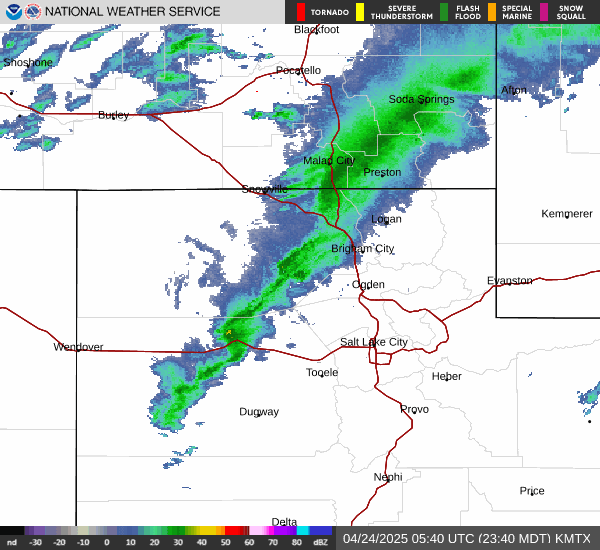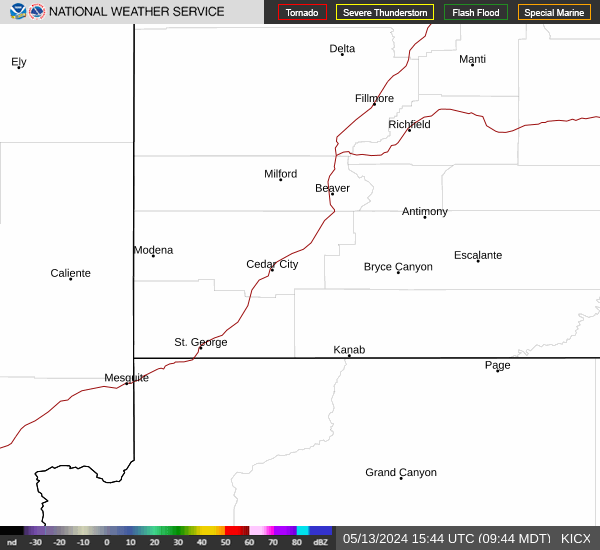
Lake effect snow will continue through Friday bringing significant snowfall to areas east to southeast of the Great Lakes. Snow squalls may impact New Year's Eve travel this evening and overnight across parts of the Great Lakes, Ohio Valley, Mid-Atlantic, and Upstate New York. Heavy rain will bring another flash flooding threat for southern California New Year's Eve into New Year's Day. Read More >
|
|
Our office operates and maintains two WSR-88D Doppler RADAR stations. One covers much of northern Utah, and is located near Promontory Point. Another covers southwestern Utah, and is located near Cedar Breaks National Monument.
Salt Lake City, UT Radar |
Cedar City, UT Radar |
 |
 |
| Link to Salt Lake City, UT Standard Radar (low bandwidth) | Link to Cedar City, UT Standard Radar (low bandwidth) |
| Link to Salt Lake City, UT Enhanced Radar | Link to Cedar City, UT Enhanced Radar |
| * Radar Status messages only available for the last 7 days | |

CAPE (Convective Available Potential Energy) - An integrated measure of the energy available for convective development, also known as the positive area on a thermodynamic diagram. Units are Joules per kilogram. Larger values are indicative of greater instability and the possibility of stronger convective activity, including thunderstorms. Values around or greater than 1000 suggest the possibility of severe weather should convective activity develop.
CIN (Convective Inhibition) - An integrated measure of the amount of energy needed to initiate convective activity, also known as the negative area on a thermodynamic diagram. Units are Joules per kilogram. The more negative this number, the more energy is required to initiate convection. This inhibitive energy can be overcome through surface heating, cooling aloft, lifting mechanisms (orographic, frontal, gravity waves, etc.)
Convective Condensation Level - The height to which an air parcel possessing the average saturation mixing ratio in the lowest 4000 feet of the airmass, if heated sufficiently from below, will rise dry adiabatically until it just becomes saturated. It estimates the base of cumulus clouds that are produced by surface heating only.
Convection Temperature (ConvectionT) - The surface temperature required to make the airmass dry adiabatic up to the given level. It can be considered a "trigger temperature" for that level.
Freezing Level - The height where the temperature is zero degrees Celsius.
Height of Stable Layer - The height (between 12,000 and 18,000 feet above mean sea level) where the smallest lapse rate exists. The location and existence of this feature is important in the generation of mountain waves.
K Index - A measure of stability which combines the temperature difference between approximately 5,000 and 18,000 feet above the surface, the amount of moisture at approximately 5,000 feet above the surface, and a measure of the dryness at approximately 10,000 feet above the surface. Larger positive numbers indicate more instability and a greater likelihood of thunderstorm development. One interpretation of K index values regarding soaring in the western United States is given in WMO Technical Note 158 and is reproduced in the following table:
below -10 no or weak thermals
-10 to 5 dry thermals or 1/8 cumulus with moderate thermals
5 to 15 good soaring conditions
15 to 20 good soaring conditions with occasional showers
20 to 30 excellent soaring conditions, but increasing probability of showers and thunderstorms above
30 more than 60 percent probability of thunderstorms
Lapse Rate - The change with height of the temperature. Negative values indicate inversions.
Lifted Condensation Level - The height to which an air parcel possessing the average dew point in the lowest 4000 feet of the airmass and the forecast maximum temperature must be lifted dry adiabatically to attain saturation.
Lifted Index (LI) - The difference between the environmental temperature at a level approximately 18,000 feet above the surface and the temperature of an air parcel lifted dry adiabatically from the surface to its lifted condensation level and then pseudoadiabatically thereafter to this same level. The parcel`s initial temperature is the forecast maximum temperature and its dew point is the average dew point in the lowest 4000 feet of the airmass. Negative values are indicative of instability with positive values showing stable conditions.
Lift Rate - An experimental estimate of the strength of thermals. It is computed the same way as the maximum rate of lift but uses the actual level rather than the maximum height of thermals in the calculation. Also, none of the empirical adjustments based on cloudiness and K-index are applied to these calculations.
Maximum Height of Thermals - The height where the dry adiabat through the forecast maximum temperature intersects the environmental temperature.
Maximum Rate of Lift - An estimate of the maximum strength of thermals. It is computed from an empirical formula which combines the expected maximum height of thermals with the difference in the environmental temperatures between the maximum height of thermals and the temperature 4,000 feet above the ground. After this computation, further empirical adjustments are made based on the value of the K-index and the amount and opacity of middle and high level cloudiness expected between the time of trigger temperature and the time of overdevelopment.
Middle/High Clouds - The amount and opacity of middle (altostratus, altocumulus) or high (cirrus, cirrostratus, cirrocumulus) clouds. Broken means that between 60% and 90% of the sky is covered by the cloud, with overcast conditions occurring when more than 90% of the sky is covered by the cloud. Thin implies that the clouds are predominantly transparent, meaning that some sunlight is reaching the ground, in contrast to opaque which suggests that little sunlight is reaching the ground.
Potential Height of Wave - The minimum of the following two heights:
1. Level above the height of stable layer (or 14,000 feet if none exists) where the wind direction changes by 30 degrees or more
2. Level above the height of stable layer (or 14,000 feet if none exists) where the wind speed no longer increases with height
PVA/NVA - Positive vorticity advection (PVA)/negative vorticity advection (NVA) on the 500 millibar isobaric surface (approximately 18,000 feet above mean sea level). Weak PVA has been shown to assist in mountain wave soaring.
Soaring Window - The time between the time the trigger temperature is reached and the time of overdevelopment.
Thermal Index - The difference between the environmental temperature and the temperature at a particular level determined by following the dry adiabat through the forecast maximum temperature up to that level. Negative values are indicative of thermal lift.
Thermal Soaring Index - An adjective rating (for sailplanes) based on the computed maximum rate of lift, and the wind speed and middle and high cloud cover expected during the soaring window (the time of the trigger temperature and the time of overdevelopment) according to the following:
Maximum rate of lift Adjective Rating
>= 800 fpm Excellent
>= 400 and < 800 fpm Good
>= 200 and < 400 fpm Fair
< 200 fpm Poor
Time of Overdevelopment - The time one or more of the following phenomena, which essentially shut off thermal lift, is expected to occur:
1. formation of broken to overcast convective cloud cover
2. formation of scattered to numerous downbursts
3. initiation of widespread precipitation
Time of Trigger Temperature - The time the surface temperature is expected to reach the trigger temperature.
Trigger Temperature - The surface temperature required to make the first 4000 feet of the atmosphere dry adiabatic.
Wave Soaring Index - An empirical, adjective rating (for sailplanes) which attempts to combine a variety of phenomena important in mountain wave soaring into a single index number. Objective points are assigned to these phenomena: wind speed and direction at 14,000 ft MSL, the static stability in the 12,000-18,000 ft MSL layer, the wind speed gradient above the stable layer, jet stream location and frontal and upper trough movements.